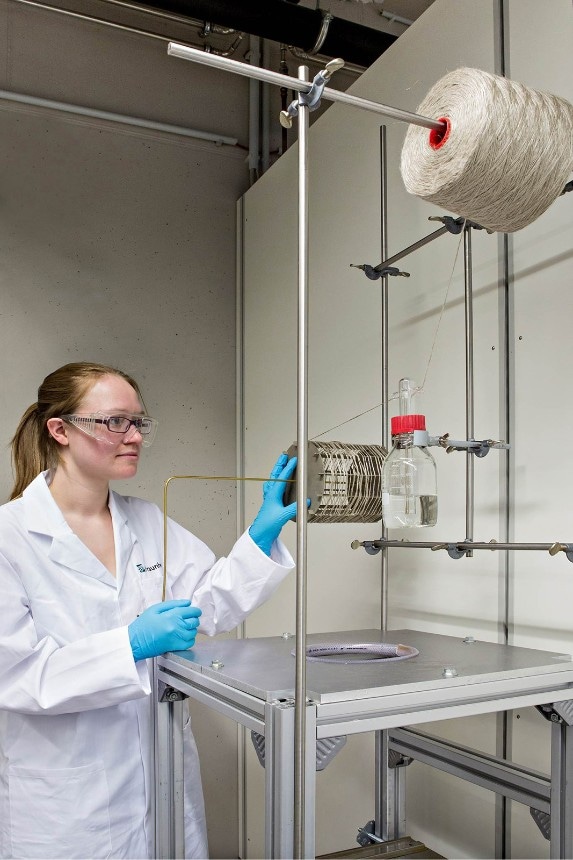Feb 5 2018
Natural fibers have a number of benefits: they are biodegradable, renewable and robust. They are more energy-efficient to develop than carbon fibers or glass, are lighter and also have improved acoustics. Their disadvantage refers to the fact that they absorb water very easily. This indeed weakens their mechanical properties. Fraunhofer researchers have now teamed up with their partners to incorporate a yarn technology and a special fiber treatment: as a result, natural fibers can completely exploit their advantages and be used in an extensive manner.
 To make the natural fibers more resistant, the roving is impregnated with monomers: the polymerization then proceeds within the yarn. (Image credit: Fraunhofer LBF)
To make the natural fibers more resistant, the roving is impregnated with monomers: the polymerization then proceeds within the yarn. (Image credit: Fraunhofer LBF)
The topic of biological transformation is a popular one. This type of management concentrates on the sustainable use of biological resources, such as microorganisms or plants. In the future, it is expected to decrease reliance on fossil fuels such as coal, oil or gas and help handle major challenges such as global population growth and climate change.
Biological transformation offers opportunities and options for almost all industries. Materials are one field of application – like natural fiber reinforced plastics (NFRP). Their benefits enable them to be used as an alternative to carbon and glass fiber reinforced plastics (GRP or CFRP): they are biodegradable, renewable and robust, are lighter, have better acoustic properties and use less energy while being produced. The disadvantage is that they absorb water extremely easily, becoming damaged as a result and losing their otherwise positive mechanical properties.
Fiber Treatment and Yarn Technology Skillfully Combined
The Fraunhofer Institute for Structural Durability and System Reliability LBF in Darmstadt, Germany has recently solved this disadvantage along with the Institute for Textile Technology (ITA) of the RWTH Aachen in the exploratory study "Bastfix", which is financially supported by the German Federal Ministry of Education and Research (BMBF).
The approach: a clever combination of special fiber treatment and yarn processing.
A surface treatment of natural fibers with water-repellent layers alone doesn’t provide any progress. The water then continues to penetrate the natural fiber via cut edges or other damage.
Dr. Roland Klein, Group Manager - Design of Interfaces, Plastics Division, LBF
Scientists have treated the fibers so that they are moisture-repellent on the inside. They performed this by developing polymers within the natural fibers.
"First, we let the monomers of the plastic penetrate into the cavities of the natural fibers. The polymerization then took place directly inside the fibers," Klein states.
The use of the method is mainly interesting for thermoplastic fiber composites since in their production, the molten polymer is extremely viscous, only wets the fibers superficially and does not penetrate into the interior. The benefit of thermoplastics: they can be deformed as wanted even after production.
New Fields of Application for NFRP
In their experiments, the researchers employed flax fibers in the form of a roving, that is, the state prior to spinning into yarns and their further processing into textile surfaces. This has the advantage that the fibers can be wholly soaked with the monomer, as they are still present separately.
Complete impregnation might not be guaranteed on twisted or fabric yarn. This is where the yarn process of the ITA becomes important. In the wrap spinning process, the Aachen scientists assemble the natural fibers in parallel and wrap the parallel core of the flax fibers with the help of a filament. The advantage: The fibers are not twisted, which provides them increased strength.
By combining both processes, the physical properties of natural fibers can be fully exploited. These two developments greatly expand the area of application for NFRP, with the result that they can also be used outdoors and in highly stressed components.
Dr. Roland Klein, Group Manager - Design of Interfaces, Plastics Division, LBF
So far, NFRPs have been used chiefly in cars, such as for the interior lining of doors.
For his research, Klein and his team received the "DNFI Innovation in Natural Fibers Award 2017". Fifteen textile organizations had established the Discover Natural Fibers Initiative (DNFI) after the 2009 United Nations International Year of Natural Fiber.